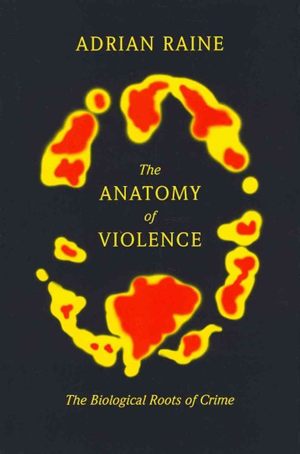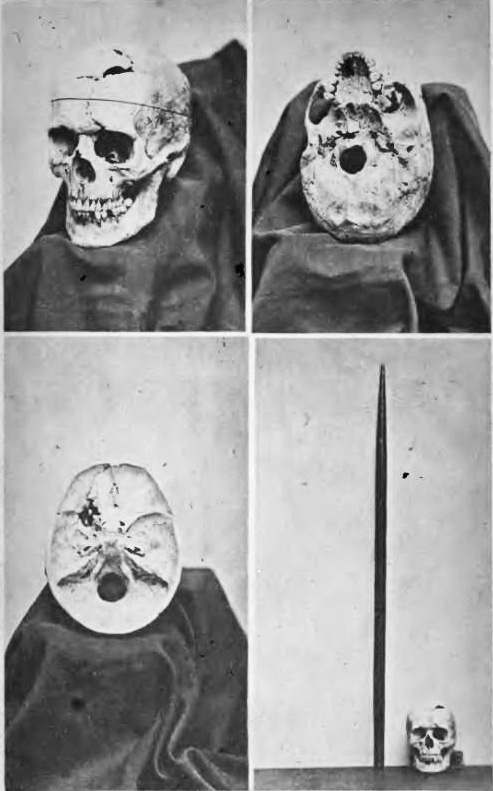The Anatomy of Violence
Jared Taylor, American Renaissance, July 5, 2013
Adrian Raine, The Anatomy of Violence: The Biological Roots of Crime, Pantheon Books, 2013, 478 pp.
The last 20 years have seen a huge expansion in our understanding of the biological basis of crime. From the end of the Second World War until the 1990s, sociological dogma held that crime was caused by poverty, “racism,” social inequality, etc. There had long been twin and adoption studies showing that crime runs in families, but orthodoxy ignored them.
Adrian Raine, professor of criminology at the University of Pennsylvania, points out that there is now too much evidence to be brushed aside. Even the top sociology journal, American Sociological Review, now publishes work on the genetics of violence it would not have dared touch 15 years ago. Prof. Raine’s book, The Anatomy of Violence, is a broad introduction to discoveries in how genes and brain structure predispose people to crime, but it also suggests a considerable environmental influence on gene expression and brain structure. There is much to learn from this book, but it is self indulgent and a chore to read.
Psychopaths
The Anatomy of Violence is about antisocial behavior of all kinds, and it comes in all gradations. Littering or talking in a library is antisocial, and in this sense, we can all be antisocial. At the other extreme are the pathological cases — psychopaths — who are of the central characters of this book.
As Prof. Raine explains, the best way to understand psychopaths is to imagine what it would be like to have no conscience. Psychopaths have only an abstract understanding of right and wrong. They do not feel the strong inhibitions against evil that come naturally to the rest of us. Many people believe moral decisions should be made calmly and rationally, but that does not always happen; most of us are held back from evil by physical sensations of revulsion. People without these sensations may do horrible things.
Prof. Riane describes the case of Jane Toppan, a Massachusetts private nurse who poisoned at least 31 people from 1895 to 1901. She would climb into bed with them and get what she called “a voluptuous pleasure” from holding them close while they died. She knew very well that what she was going was “wrong” but she had no feelings of wrongdoing. She was shocked when she was found not guilty by reason of insanity, because she considered herself perfectly sane.
Toppan was the typical conscienceless psychopath, unusual only because psychopaths and serial killers are almost always men. Prof. Raine says that about 3 percent of the male population are psychopaths, though they are not all violent. They tend to be charming, accomplished liars, and when they are smart enough to stay out of jail they can be ruthlessly successful. We have probably had psychopaths — certainly borderline psychopaths — as Presidents.
Most psychopaths are eventually exposed as heartless bloodsuckers, but they just move on to the next scam. Prof. Raine says that temp agencies are perfect for them; they can drain every advantage out of a temporary job and move on before they are caught. Despite their skill with people, psychopaths are not good at reading unhappiness, fear, or sadness in people’s faces. This is no doubt connected to the fact that they are utterly indifferent to such feelings in others.
But how do they get that way? Prof. Raine cites many studies showing that their brains are different. Their amygdalae, two almond-sized organs in the brain, are 18 percent smaller than in normal people. Brains scans show that the amygadalae are active when we are imagining morally perplexing problems. When psychopaths think about the same situations, their stunted amygdalae hardly flicker.
If it were only a matter of underdeveloped brains, it might be possible to blame psychopathy on malnourishment, but some parts of psychopaths’ brains are larger than normal: the right hippocampus, the striatum, and the corpus callosum. The corpus callosum is what links the left and right hemispheres, and psychopaths have larger, stronger links. This may be why they are so persuasive. Most of us use only our left brain for talking, but with better connections, psychopaths may be using both hemispheres.
Psychopathy does not necessarily make people violent, however, and plenty of violent people are not psychopaths. What causes violence?
It has long been theorized that many violent people are simply at a low state of arousal. They need more excitement than the rest of us, and crime, rape, violence, and cruelty excite them. Prof. Raine argues convincingly that a low resting heart rate is a very strong sign of the kind of low arousal that can lead to violent thrill-seeking. He says that as early as age three, an unusually low heart rate is a very accurate predictor of aggressiveness in little boys — even better than having a criminal parent, which is one of the best predictors.
Boys have lower heart rates than girls and are more aggressive, but girls with unusually slow pulses are also likely to be violent. Heat rate is lowest in adolescence, the age at which people are most antisocial and seek the wildest thrills. Children and adults with low heart rate are also less moved by the sufferings of others and may even enjoy inflicting pain. They are also fearless and less bothered by stress.
One key to their behavior may be that they shrug off punishment. When normal children are punished for being selfish or pushy, it changes both their behavior and the way they think about being pushy. Not so for children who may well become psychopaths. Those with a low heart rate are not afraid of punishment and it doesn’t change them. They do not develop a conscience.
Even among animals, a slow pulse is associated with dominance and aggression. The alpha rabbit in a herd is likely to have a slow pulse, and if a subordinate male rabbit’s status is artificially raised in an experiment, his pulse rate drops.
Prof. Raine notes that physical markers like this are usually associated with a variety of different mental conditions and various kinds of behavior. Low resting pulse, however, is linked only with antisocial, aggressive behavior, and predicts it with remarkable accuracy. Low heart rate and the behavior that often comes with it are also heritable.
Brain structure
The pre-frontal cortex plays an important part in controlling behavior, and when it is damaged, people may change completely. In 1848, Phineas Gage had an accident that destroyed part of his pre-frontal cortex, which controls many higher human functions. When he recovered, he was no longer a reliable working man; he became an impulsive, sexually promiscuous drunk and a drifter. There is also the famous case of a man who suddenly started watching kiddie porn and molesting his step daughter after years of being a perfect father. He had a tumor growing in his pre-frontal cortex, and cutting it out cured him. It reappeared, he went back to perversion, and surgery cured him again.
The opposite can happen. A 33 year old with a long history of aggression and cussedness shot himself in the head with a cross bow, knocking out a piece of his pre-frontal cortex. He became docile and cheerful.
The brains of many of the worst criminal offenders are noticeably different from ours. They have about 11 percent less gray matter in the pre-frontal cortex, and they tend to show distinct differences in such areas as the angular gyrus, the posterior cingulate, and the middle frontal gyrus.
The differences between male and female brains are in the same direction, with men having brains that are more criminal and psychopathic than those of women. As Prof. Raine explains, “More than half of the reason men and women differ in crime seems to be because their brains are physically different.”
The limbic system plays an important role in violence. This is a primitive part of the brain that is associated with rage and violent urges. Some criminals seem to have disordered limbic systems that make them subject to wild furies. If, at the same time, their pre-frontal cortex is not working well to restrain them, they are likely to be violently cruel. Successful serial killers, on the other hand, often have very good pre-frontal function. They can control themselves enough to plan their crimes and elude the police. Frequent, successful lying requires a good pre-frontal cortex, too, because liars have to tell consistent, plausible lies.
Prof. Raine says that brain scans are good at telling who is lying, and predicts that one day they will be used in court. Scans also reveal the signs of psychopathy and potential violence, but there are still false results, both positive and negative.
Humans can be accomplished liars by the age of four. Prof. Raine recounts a study in which children were told not peek at something while an experimenter left the room. Unbeknownst to the child, he was filmed, and he was also filmed when the experimenter asked if he had peeked. When adults or even customs inspectors — who are trained to catch liars — watched only the questions and answers on video, they distinguished the liars from the truth-tellers at no better rate than if they had guessed.
Genes
A tendency toward antisocial behavior and crime is, of course, heritable. Twin and adoption studies give us a figure of about 50 percent. There are two kinds of violence: unprovoked and reactive. Self-starting violence is more heritable than reacting violently to a provocation. Heritability rates are highest for the most spectacular, repeated, callous kinds of violence. If your father is a brutal career-criminal, there is a very good chance you’ll be a criminal, too.
Wife-beaters are usually reactive. They are hyper-sensitive and fly into violent rages — and not only at their wives. The feminist view — that wife-beating is a cold, calculated way to control women — is almost always wrong.
The volume of neurotransmitters in the brain has a lot to do with levels of violence. There are more than 100 neurotransmitters, and many of the genes that code for their production have been found. Low levels of serotonin make people more rash and potentially violent, and animal experiments show that high levels of dopamine fuel aggression while low levels reduce it.
One enzyme that metabolizes several neurotransmitters is known as MAOA. There is a variant of the MAOA gene that makes the body produce less of the enzyme, and leads to an intolerance of criticism and high aggression in both men and women. It has become known as “the warrior gene,” and is more common in Maoris (56 percent) than in whites (34 percent). Maoris have a tradition of ferociousness, and survived wars of extermination before whites came to New Zealand. Maoris may have been selected for violence, and today they have higher crime rates than whites. On the other hand, 77 percent of Chinese have the low-MAOA gene.
Environment
Genes and brain structure clearly contribute to crime. Some people are born botched. Prof. Raine recognizes this — and he thinks he’s very brave to do so — but what role does environment play? A surprisingly big one, according to him.
Prof. Raine notes that different environments can breed different personality types. The Kung Bushmen live in the harsh Kalahari desert, and men must cooperate on the hunt and share food in order to survive. Parents also must take good care of children or they die. There is little violence and a lot of cooperation in Kung society.
The Munducuru of the Amazon live in a different world. Food grows easily, and women do most of the work. Men spend their time fighting, head-hunting, and in elaborate ritual ceremonies. Women do not put much effort into child-rearing and men virtually none at all. Boys are taught the advantages of violence at a very early age. The entire society is basically psychopathic by our standards.
As Prof. Raine notes, that can be adaptive. The Yanomano of Venzuela are similar to the Munducuru and much better known. Among them, violence pays off. Forty-four percent of Yanomano men have killed someone, and killers have an average of five children while non-killers manage only 1.6. Munducuru women are attracted to killers, too. Over time, different environments cause different kinds of people to evolve. This has obvious relevance for other populations — blacks and whites, for example — but Prof. Raine is mute on that subject.
At the individual level, the most obvious environmental effect on the brain is physical damage, which, as we saw, can completely change personality. But the damage need not be as dramatic as a cross-bow bolt through the cortex. Prof. Raine writes that many of the worst criminals had head injuries when they were children, which probably damaged their brains.
Reckless mothers routinely damage their children’s brains while they are still in the womb. One study found that just one alcoholic drink a week raised the chances of antisocial behavior. Smoking during pregnancy reduces oxygen flow to the fetus, which harms brain development and can lead to violence.
There are slight physical defects — called anomalies — that are signs things did not go well in the womb: ears set low on the head, a wide gap between the big toe and the other toes, ear lobes that are connected to the neck, little fingers that are curved, a streak down the middle of the tongue. People with a lot of these anomalies are more likely to be aggressive or criminal.
Prof. Raine cites a number of studies that suggest a bad home life — especially one without a close attachment to Mom — can change how the brain develops. The early environment may actually affect the way genes are expressed. Prof. Raine claims that rats have more than 900 genes whose expression is known to be altered by whether a rat pup is licked regularly by its mother. Licking produces changes in the hippocampus that help rats deal better with stress. As a rule, says Prof. Raine, gene expression is thought to be most powerfully affected in the womb and immediately after birth.
It turns out that many criminal psychopaths were passed around as children and never developed a bond with their mothers. Others had mothers who abused or neglected them. A good mother-son bond seems to help develop a conscience. When groups of boys are matched for physical anomalies of the kind described above, those with bad attachments to mothers are even more likely to be criminals.
Lead damages a child’s brain. Prof. Raine writes that eliminating lead from paint and gasoline is probably what caused the drop in crime rates since the early 1990s. He also writes that when populations are otherwise similar but one eats fish and the other does not, the fish-eaters commit less crime. Omega-3 fatty acids may help the brain develop normally.
Traumatic experiences also affect the brain. Prof. Raine reports that sexual abuse at ages three to five shrinks the hippocampus. Abuse at ages 14 to 16 reduces pre-frontal cortex volume. Both areas of the brain are associated with criminal behavior.
Sometimes, however, even with the best of environments, a child may simply be born with a defective brain and a low level of arousal that make it likely he will be a criminal. So what do we do with this information?
Prof. Raine argues that we may have to rethink the concept of guilt. Some people have such damaged, crime-prone brains they can’t help themselves. We are tempted to forgive the man who molested his step daughter only when he had an actively growing brain tumor. But how is he different from people who are born with a similarly defective brain but don’t have a tumor?
The conclusion of this book is not that since crime is rooted in biology there is nothing we can do about it. Instead, Prof. Raine has astonishingly invasive proposals. He says that once the technology is a little better tuned, all boys should get mandatory brain scans and DNA tests. The ones with the worst readings, especially if they are in bad homes, should go into indefinite detention. “Just as we screen for cancer to prevent deaths,” he explains, “we should also screen for violence to prevent loss of life.” These institutions would not be punitive, but would set boys on the right track with anti-psychotic drugs, biofeedback, and lots of fish. Inmates would be released when they were thought no longer to be dangerous.
Prof. Raine imagines a day when screening techniques are so good it is possible to pick out future killers with essentially 100-percent accuracy, and says it makes sense to take them off the streets before they hurt someone. To shocked civil libertarians, he argues that “society over the years is also becoming more controlling.”
A more sensible idea is to prevent people with strong, heritable criminal traits from having children. Prof. Raine notes that to some degree we already do, because people are almost never able to reproduce once they are in prison. He muses about letting only licensed adults have children, but wonders, “How do we know that the bad old days of eugenics are really over?” As he should know, the “bad old days” were not that bad; nine-tenths of the charges against eugenics are either false or pure hysteria. Which is worse? Preventing bad specimens from reproducing or — as Prof. Raine prefers — locking up their children indefinitely before they even commit a crime?
Aside from his brief mention of the MAOA “warrior” gene, Prof. Raine says nothing at all about race differences in genes or brains structure. And yet, there are sure to be such differences. Richard Lynn argues persuasively that blacks have unusually high rates of psychopathy, and the high levels of callous brutality common in Africa and among black populations everywhere surely reflect biological differences. These will come to light eventually, though researchers will no doubt make every effort to hide them.
I noted earlier that this is an annoying book. Part of the problem is that Prof. Raine thinks he is fascinating, and writes about himself all the time. He also repeats himself, gossips about other researchers, and tries to divert us with chatty stories about the lives of serial killers, whom he refers to by first name: “Randy” Kraft, “Jimmy” Filiaggi, etc. It is surprising that Pantheon published such amateurish writing; a good editor would have got rid of at least 150 pages.
There is good information here, but you have to wade through muck to get it.



















